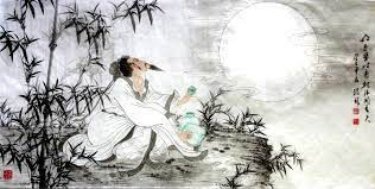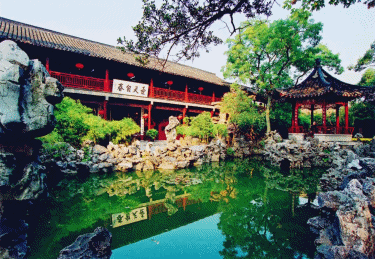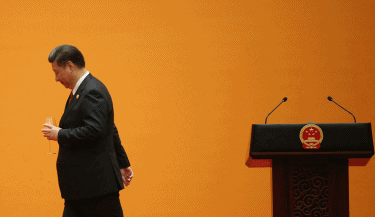Category Archive 'China'
22 Mar 2023


Some Putin-worshipping Paleocon morons were recently posting on FB Russian Defense Ministry claims that Russia is winning the war in Ukraine.
Well, here’s a Vodkapundit posting that addresses just how well Russia’s doing. The orcs have lost so much armor, they are reduced to sending out early 1950s tanks to the front. And Russia has joined a Chinese New World Order basically accepting the role of vassal to China in exchange for rather limited Chinese support! So, tell me, Cheese-Eating-Surrender-Monkeys, who is it that’s losing the war?
Having lost more than 3,000 capable main battle tanks from the late-’60s vintage T-64s through fully modernized T-90s, Moscow was pulling far less capable T-62 medium tanks out of storage.
Well, if the T-62 is a museum piece, then the T-54/55 series — whose development began before the Cold War officially began — is practically an archeological exhibit. And yet those very same tanks, first built when toddler Boomers were grooving on the first season of Howdy Doody, have been spotted on railcars moving west towards Ukraine from Soviet-era depots in the east. …
Firepower is firepower. If a 75-year-old design can be used for infantry support (it wouldn’t last a hot minute in the main battle tank role), then those foot soldiers are better off with a T-55 nearby than without one. …
Xi was in Moscow this week for high-level talks with Putin, and those talks have already gone a long way towards establishing that new New World Order — one very friendly to Chinese interests. Much more important than the phony-baloney peace plan Xi put on the table earlier this week is the trade deal just announced between Beijing and Moscow.
Reuters reported Wednesday that the summit “produced 14 agreements on topics from soybeans to atomic energy.” Chinese tech will help Russia ride out Western sanctions and carry on the war in Ukraine, and Russian natural resources will help make China less reliant on vulnerable sea lanes. However, Reuters said, the agreement “did not yield the big prize Russia wants: a deal on a new gas pipeline.”
“There are two likely sticking points: who will build the 2,600 km pipeline and how the gas will be priced. China is well placed to drive a hard bargain, as Moscow needs the deal more,” and so the bottom line is that “China has powerful leverage to secure advantageous price terms.”
A Financial Times report quoted Maria Shagina, a senior fellow at the International Institute for Strategic Studies: “It’s hard to hide the fact that Russia is now a junior partner.” China has two kinds of foreign relationships: Trade partners and vassal states. Putin’s stupid war is demoting Russia from partner to vassal.
RTWT
29 Oct 2022


Dennis Zhou reviews Wong May’s In the Same Light: 200 Tang Poems.
In 755, the Sogdian-Turkish general An Lushan rebelled against Emperor Xuanzong of the Tang dynasty after a dispute with a cousin of the emperor’s favorite concubine. Within a year, the general had captured the eastern capital of Luoyang and declared himself emperor; the next year, his forces seized and sacked the capital of Chang’an (present-day Xi’an), then the most populous city in the world. Although An—blind, crazed, and so obese that he was said to crush horses to death under his own weight—was assassinated in 757 by a eunuch conspiring with his son, the rebellion continued for several years until finally being put down by the imperial army in 763. As many as 36 million people were killed or displaced during the insurrection—three-quarters of the population. The Tang dynasty never fully recovered, and after suffering another uprising in the ninth century, China descended into civil war, ending what many consider its Golden Age.
This era of war and famine coincided with an immense flowering of calligraphy, painting, and poetry. In the eighth century, Chang’an had become a bustling, cosmopolitan city with countless canals, parks, teahouses, and monasteries and a diverse population that included Uighurs, Turks, Japanese, and Koreans. With the imperial examination system, which recruited bureaucrats on the basis of their knowledge of classical literature and philosophy, poetry was elevated to a stature that it has rarely, if ever, reclaimed: a class of scholar-officials governed the empire, and no one could rise in the ranks without the ability to compose an elegant quatrain or a witty couplet.
The Tang Dynasty, which lasted more than 270 years, produced China’s greatest poets: the Daoist drifter Li Bai, the Confucian poet-historian Du Fu, the painter-poet Wang Wei, the Buddhist hermit Han Shan, and many others. Their lives were marked by unceasing political turmoil. Refugees and fugitives, they spent their years wandering from place to place, falling in and out of imperial favor and all the while drinking, singing, and writing. Their poetry—for the most part regulated verse comprising linked couplets of between five and seven characters—is what we think of when we think of Classical Chinese poetry.
The astounding influence that Chinese poetry in translation has had on the English language throughout the 20th century—from the Modernist, Imagist revolution of Ezra Pound’s Cathay (1915) through its mid-century, counter-cultural incarnation by Gary Snyder, Kenneth Rexroth, and others—can be traced to this ragtag assortment of drunkards, hermits, and exiles. Very few collections, however, situate the Tang poets fully within their political and historical context, drawing out both the urgency and stakes of their verse. Many anthologies… simply follow the model of Three Hundred Tang Poems (1763) compiled by the Qing scholar Sun Zhu, which for many decades remained the standard text. In the Same Light (The Song Cave, 2022), translated by the Chinese-Singaporean-Irish poet Wong May, does something different. Collecting 200 poems by 38 poets, Wong May promises to find parallels between their time and the present and, in so doing, update them “for our century.” To do this, she excavates her own story and its resonance with those of the Tang poets.
RTWT
25 Jul 2022


The Ge Garden in Yangzhou, which was to have been replicated in the National China Garden at the National Arboretum.
MSN:
On paper, it looked like a fantastic deal. In 2017, the Chinese government was offering to spend $100 million to build an ornate Chinese garden at the National Arboretum in Washington DC. Complete with temples, pavilions and a 70-foot white pagoda, the project thrilled local officials, who hoped it would attract thousands of tourists every year.
But when US counterintelligence officials began digging into the details, they found numerous red flags. The pagoda, they noted, would have been strategically placed on one of the highest points in Washington DC, just two miles from the US Capitol, a perfect spot for signals intelligence collection, multiple sources familiar with the episode told CNN.
Also alarming was that Chinese officials wanted to build the pagoda with materials shipped to the US in diplomatic pouches, which US Customs officials are barred from examining, the sources said.
Federal officials quietly killed the project before construction was underway.
The canceled garden is part of a frenzy of counterintelligence activity by the FBI and other federal agencies focused on what career US security officials say has been a dramatic escalation of Chinese espionage on US soil over the past decade.
Since at least 2017, federal officials have investigated Chinese land purchases near critical infrastructure, shut down a high-profile regional consulate believed by the US government to be a hotbed of Chinese spies and stonewalled what they saw as clear efforts to plant listening devices near sensitive military and government facilities.
F.E. Warren Air Force Base, a strategic missile base, is located in Cheyenne, Wyoming, an area near a host of cell towers using Huawei equipment. – From F.E. Warren Air Force Base/Facebook
US Attorney for the Eastern District of New York Richard P. Donoghue announcing indictments against China’s Huawei Technologies Co Ltd, several of its subsidiaries and its chief financial officer Meng Wanzhou on January 28, 2019.
RTWT
23 Jan 2022
She has little space, but a helluva lot of gadgets.
HT: Vanderleun.
17 Oct 2021


The new hypersonic glide vehicle was launched with a “Long March” rocket.
The Financial Times tells us today, in Mid-October, that China last August tested a nuclear-capable hypersonic glide vehicle featuring new technology that our military doesn’t understand and giving China a first-strike capability we have no way to counter.
China tested a nuclear-capable hypersonic missile in August that circled the globe before speeding towards its target, demonstrating an advanced space capability that caught US intelligence by surprise.
Five people familiar with the test said the Chinese military launched a rocket that carried a hypersonic glide vehicle which flew through low-orbit space before cruising down towards its target.
The missile missed its target by about two-dozen miles, according to three people briefed on the intelligence. But two said the test showed that China had made astounding progress on hypersonic weapons and was far more advanced than US officials realised.
The test has raised new questions about why the US often underestimated China’s military modernisation.
“We have no idea how they did this,” said a fourth person.
The US, Russia and China are all developing hypersonic weapons, including glide vehicles that are launched into space on a rocket but orbit the earth under their own momentum. They fly at five times the speed of sound, slower than a ballistic missile. But they do not follow the fixed parabolic trajectory of a ballistic missile and are manoeuvrable, making them harder to track.
Taylor Fravel, an expert on Chinese nuclear weapons policy who was unaware of the test, said a hypersonic glide vehicle armed with a nuclear warhead could help China “negate” US missile defence systems which are designed to destroy incoming ballistic missiles.
“Hypersonic glide vehicles . . . fly at lower trajectories and can manoeuvre in flight, which makes them hard to track and destroy,” said Fravel, a professor at the Massachusetts Institute of Technology.
RTWT
05 Oct 2021

In Foreign Affairs, Michael Beckley and Hal Brands explain why the Chinese Miracle is soon going to be over.
China’s multidecade ascent was aided by strong tailwinds that have now become headwinds. China’s government is concealing a serious economic slowdown and sliding back into brittle totalitarianism. The country is suffering severe resource scarcity and faces the worst peacetime demographic collapse in history. Not least, China is losing access to the welcoming world that enabled its advance.
Welcome to the age of “peak China.” Beijing is a strong revisionist power that wants to remake the world, but its time to do so is already running out. This realization should not inspire complacency in Washington—just the opposite. Once-rising powers frequently become aggressive when their fortunes fade and their enemies multiply. China is tracing an arc that often ends in tragedy: a dizzying rise followed by the specter of a hard fall.
Read the rest of this entry »
/div>

Feeds
|









